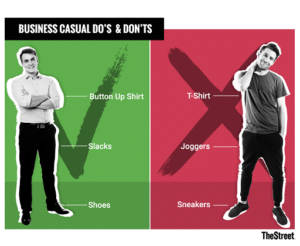In the professional world, the term “business casual” has become increasingly prevalent. It’s a dress code that bridges the gap between formal business attire and casual wear. Understanding what business casual means for men is crucial to projecting a polished and professional image while still being comfortable. Here’s a comprehensive breakdown:
Defining Business Casual

Business casual attire varies across industries and workplaces, but it generally implies a blend of professional and informal wear. It’s less formal than a traditional suit-and-tie ensemble but more polished than casual clothing. For men, it typically includes:
Tops for Men
- Shirts: Dress shirts are a staple, often worn without a tie. Opt for solid colors, subtle patterns, or checks.
- Polo Shirts: These can be a more relaxed alternative, especially in warmer climates or creative industries.
Bottoms for Men
- Trousers: Khakis, dress pants, or chinos in neutral shades like navy, grey, or beige.
- No Jeans: In most business casual settings, jeans might be too informal unless the workplace explicitly permits them.
Jackets and Blazers
- Blazers: Versatile and sophisticated, blazers in neutral tones complement the business casual look. They can be paired with trousers or chinos.
Footwear Choices
- Shoes: Leather loafers, derbies, or dressy boots. Sneakers can be acceptable in more relaxed work environments, but opt for clean, understated styles.
Accessories and Extras
- Ties and Accessories: Ties aren’t mandatory in a business casual setting, but if worn, opt for subtle patterns or solid colors. Accessories like belts and watches should complement the outfit without being too flashy.
Understanding the Workplace Expectations
Different workplaces interpret business casual differently. Understanding your company’s culture and expectations is crucial. Here are some considerations:
Company Policies
- Employee Handbook: Check your company’s official guidelines or dress code policies. Some workplaces have specific rules regarding business casual attire.
- Observe Colleagues: Take cues from what your colleagues and superiors wear. It can provide insights into the acceptable dress code.
Occasions and Meetings
- Client Interactions: Dressing slightly more formal than the company’s usual business casual standard might be appropriate when meeting clients or during important presentations.
- Casual Fridays: Some workplaces have designated “casual Fridays,” where the dress code might be more relaxed.
Tips for Nailing the Business Casual Look

Fit Matters
- Ensure your clothing fits well. Avoid anything too tight or overly baggy, as a good fit contributes significantly to a polished appearance.
Personal Grooming
- Maintain a well-groomed appearance. Neat hair, trimmed nails, and clean shoes are essential elements of a professional look.
Versatility and Layering
- Utilize layers to create versatile looks. A blazer can be added for a more formal touch or removed for a more casual appearance.
Comfort with Professionalism
- Find a balance between comfort and professionalism. Business casual should make you feel at ease while still presenting a competent and professional image.
Adapting Business Casual to Your Style
Business casual doesn’t mean sacrificing personal style. With a few adaptations, you can express your personality while adhering to the dress code.
Experiment with Colors and Patterns
- Incorporate subtle patterns or colors to add a touch of personal flair without deviating from the professional tone.
Personal Accessories
- Accessories like pocket squares, cufflinks, or a statement watch can add personality to your outfit without being too distracting.
Seasonal Adaptations
- Adjust your wardrobe according to the season. Lighter fabrics in summer and layering options in winter can make business casual more comfortable.
understanding what business casual means for men is essential to navigate the professional world. It’s about balancing professionalism with comfort and personal style. By adhering to the key principles and adapting them to your workplace’s expectations, you can master the art of business casual dressing while making a lasting and positive impression.
Remember, business casual is not a one-size-fits-all concept. It often varies from one workplace to another. Pay attention to your company’s culture and guidelines to strike the perfect balance between professionalism and comfort.


